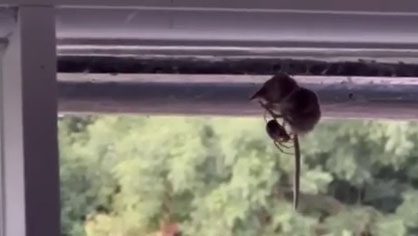The noble false widow spider measures only about 1 cm in length but can prey on vertebrates thanks to its potent venom and strong silk strands.

Spider preying on a shrew.
Most spiders pose little danger to humans, including the noble false widow spider (Steatoda nobilis). However, this predator, measuring only about 1 cm, possesses impressive capabilities. For example, it can hunt vertebrates such as lizards, bats, and even shrews, as reported by Science Alert on August 26.
Zoologist Dawn Sturgess from the University of Galway captured footage of a female noble false widow spider taking down a pygmy shrew (Sorex minutus) in a house in Chichester, southern England. The research, led by zoologist Michel Dugon at the University of Galway, was published in the journal Ecosphere.
In comparison to the noble false widow spider, the pygmy shrew is a relatively large creature, typically measuring about 5 cm in length, plus a 4 cm long tail. It is three times longer than the spider (not including the tail) and weighs around ten times more. Like true widow spiders (including the black widow and the redback spider), the noble false widow spider overcomes its sizable prey through a combination of strong venom and resilient silk.
(Video: Science Alert)
The research team stated that the pygmy shrew was still alive when caught in the spider’s web, even though it made only a few slight movements. This may be due to the spider’s highly potent neurotoxin, which quickly paralyzes muscle nerves. The spider moved back and forth between the pygmy shrew and a beam above the window, using silk to hoist the prey about 25 cm off the ground.
After 20 minutes, the spider had pulled the prey up to the beam, partly out of sight. It wrapped the pygmy shrew in silk and consumed it over three days, later dropping the remaining parts down from the web. The experts noted that what was left consisted only of fur, bones, and skin.
They are unsure how the spider initially captured the pygmy shrew, but it is likely that it was not a chance encounter. It is possible that the shrew climbed up a wisteria bush near the bedroom window and was ensnared by the spider’s silk, paralyzed by its venom, and then lifted to the beam.
The research team explained that this is the third report in five years of noble false widow spiders capturing vertebrates, and their methods indicate that they have adapted to hunting this type of prey. This is the first time a member of the Theridiidae family has been recorded hunting shrews in Ireland and England. This is also the first documented case in the world of a spider hunting a shrew.
The noble false widow spider is native to Madeira and the Canary Islands but has become an invasive species in several other parts of the world, including England. This invasive species can pose problems for humans and wildlife, making further study of this spider significant.


















































